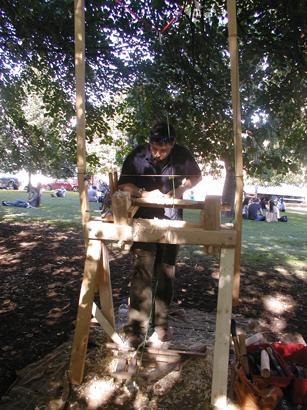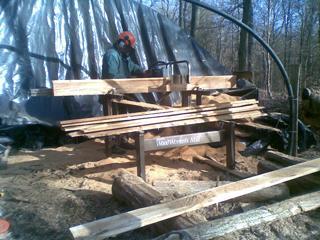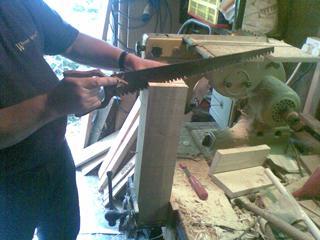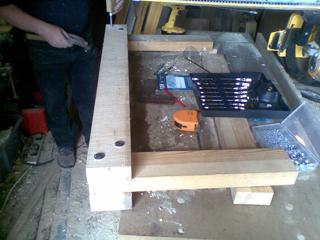
As mentioned in our latest blog our new folding show lathe has finally had its debut. This lathe has been in the pipe line for some time but due to other work commitments it has taken us longer than planned.
The basic design brief (to use a management term) was a lightweight lathe that would fold to allow ease of storage and movement for shows and demonstrations.
From the outset we wanted at least some of our own wood in the lathe, so we chose to mill some ash felled in the winter of 2010/11 from our own coppice. This would mean that the lathe was light and strong. So here is the story:
We found the basic plans for the lathe bed in the Bodgers Gazette. These where reprinted from the very first edition and advertising the release of a new book. The lathe in essence is a traditional two rail lathe with folding legs replacing the fixed A frame.


As we have said we wanted some of our own timber used in the contraction so, the first job then was to mill out the timber for the poppets (the blocks of wood that hold the centres) and the lathe bed, using our Logosol chainsaw mill. Once milled the green timber had to be seasoned under cover for several months.
Once the ash was seasoned and the centres bought (from The Woodsmith’s store)
We started the construction of the lathe. The plans use Mike Abbott’s poppet design (traditional hammerhead type) so these were cut from some of the larger sections of ash.


Then the bed and wedges came from thinner ash sections. Of course if you don’t have your own woodland and a saw mill all of this could be constructed from brought softwood.
For the legs, poles and spreaders we used timber we had in store that was left over from a lifetime’s DIY, as well as hinges etc bought from a well-known DIY store.
We found that the folding legs had to be able to stop against the lathe bed to give extra strength. This meant using hinges with removable pins; otherwise it is imposable to screw the hinge plates onto the legs. The problem with these hinges is that there is some free movement so spreaders are needed to keep the legs in place. These can simply made from bits of roofing baton.
Now the bed of the lathe was complete we moved on to the bungee poles. As we wanted to be able to transport the lathe in the back of an estate car we decided to try a new idea in poles. We took our length of timber (2in X 2in) and cut it in half. We then placed a hinge either side of the cut and replaced the pins of the inside hinge with R clips. This means that you can fold the poles down for transport. After using this lathe at Winchester we decided to strengthen the poles by bracing between them at the top as the hinges had started to bend.
© Three Copse Woodland Products 2002 – present
Postal Address:
Wesnet Services Ltd
289 London Road
Horndean
Waterlooville
Hants
PO8 0JE
Office hours 09.00 to 18.00 Monday to Friday.
Phone: (023) 92595147